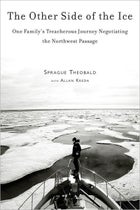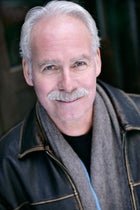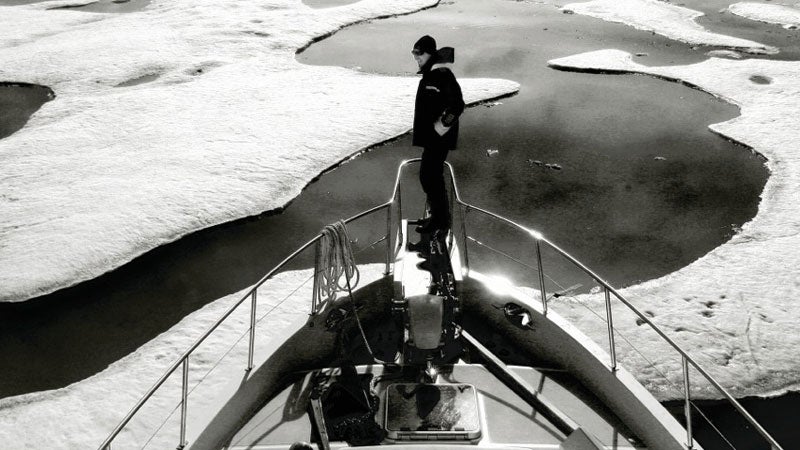When and his wife divorced in 1992, time and distance began to wear away at his relationship with his children.
Making History
Since Roald Amundsen completed the first successful crossing of the Northwest Passage in 1906, only 24 pleasure craft have followed in his wake—many of who died along the way. The Other Side of the Ice
The Other Side of the Ice Author Sprague Theobald
Author Sprague Theobald The Bagen, a seaworthy vessel
The Bagen, a seaworthy vessel“Regardless of how hard a family works during a divorce, there is almost always going to be that very large elephant in the middle of the room, sometimes for years,” he says. “At one point or another it has to be acknowledged.”
So in 2009, Theobald grabbed the elephant by the tusks and took his family—his son, stepson, stepdaughter, and her boyfriend—on an 8,500 adventure across the Northwest Passage. From their starting point in Newport, Rhode Island, through the passage and around Alaska to Seattle, their journey was almost always a contast battle with ice, polar bears, and extreme weather.
“Doing something new and adventurous builds a new history, one that is valid and present and can be referred back to time and again,” says Theobald, who wrote about the trip in his book .
We caught up with Theobald via email to talk about the trip, his book, and if spending time outdoors can heal damaged relationships.
Did you know going into your voyage that the journey would result in a memoir and a documentary?
When the idea of the trip occurred to me, all I had in mind was the hope to carve a documentary out of it. At the time my focus was climate change. It was by divine intervention that my family joined and got involved. My stepdaughter, Dominique, and I had done several thousands of offshore miles together. My son, Sefton, hadn’t done so many, but college was keeping him from being able to do the full Arctic trip. My stepson Chauncey and I hadn’t spoken in over 12 years. About a month before we were to depart from Newport, I got an email from him asking if he could be a part of this adventure. After years of trying to initiate a dialog with him, I jumped at the chance. Dominique freed up her schedule and Sefton had a semester of college waived. The kids all knew that I was going to be doing the documentary about climate change but that was pretty much all they knew. Once the trip started and we were all under the same roof, all together for the first time in 15 years, I quickly saw that the real story was about family. There was no filming agenda to uncover feelings or discuss past history. If this new angle was going to work, it was going to have to be organic and on the kids’ terms. The chances were very good that it may not have worked at all. Such is the gamble you make when producing documentaries!
As for the book, I had no plans to write a book–life was hard enough! About six months after the trip ended, an article was done about it and an agent in New York read it and tracked me down. Over many cups of coffee, he talked me into writing a book about the experience. It was the best coffee meeting I ever had!
You embarked on this journey 15 years after your divorce. What took you so long?
It took that long because as a filmmaker and sailor I was pretty busy chasing down jobs that would have immediate effect: pay. The Northwest Passage trip took seven very long years of planning and fundraising. Nordhaven Yachts quickly jumped aboard and said that they would meet every dollar of my budget. Sadly, three months before we left for the trip, Nordhaven had to pull every penny of their proposed funding. We had met a year earlier when they had told me they would cover the entire budget. I had also met with an ex-executive at a major sports channel who said, “You’ll never have to spend another dime on the trip. We want it and you!” I never heard from him again. As it ended up, all the funding came out of my own pocket—something I will be dealing with for a very long time to come.
To answer the question about why it took so long to get the kids together: After the divorce, each child and I had spent time together, one-on-one, but as life goes, never all together at the same time. After a few years, due to justified hurt and sadly avoidable miscommunications, Chauncey and I spent absolutely no time together. The kids moved to the other side of the country with their mom and visiting became a bit more challenging. In any given situation or disagreement there are two very distinct and appropriate realities. As the kids spend more time with their mother, they very naturally and rightly experience life according to one reality. There were many past scenarios which may or may not have been accurate, that they learned as truth. There were many untold hurts and angers, which I wasn’t able to address all at once. At the time of the divorce, they were very young and I didn’t want to overwhelm the kids with “he saids” and “she saids.” I just hoped that as they grew they would become more curious about me and my life decisions.
What were the group dynamics starting out?
Starting out, the dynamic was great: excitement and anticipation of trying to accomplish something so few ever have kept us going. It’s estimated that more men have walked on the moon than have successfully done the passage in one season.
And how were the dynamics by journey’s end?
As with any trip, in an expedition of this nature there were casualties along the way. The one major casualty was that Dominique and Clinton decided not to continue their relationship while we were in Greeenland, but wanted to continue the trip. Shortly after that, the appropriateness of her decision became very apparent to me as I found that Clinton’s offshore experience wasn’t quite what I was led to believe. After several very unacceptable incidents aboard the ship, he very ungraciously parted ways with us in Nome. I was qualified to run the boat as I have about 40,000 offshore miles, but the whole point in hiring Clinton was to help run the ship so that I could concentrate on the film. From the start I found that our plan simply didn’t work. It was prearranged that due to his work schedule Greg would have to leave early as well.
A lot of families go through difficult situations; why do you think spending time outdoors can help people move on?
I was hoping was that there wasn’t a prescribed way of dealing with it. Just as I didn’t want to ignore it for the rest of my kids’ lives, I also didn’t want to ask everyone to “gather ’round” because I needed to get some facts straight. When you have a third focus, such as we did–a very powerful, brutal, and life-threatening focus, you learn a heal of a lot more about what a person is made of and what makes them tick. It was my hope that my kids saw, under extreme pressure from before the start of the trip, who I was and what I would accept in my life. On the trip it was the kids and me, not the kids trying to watch their mother and me work through insurmountable issues.
Why did you choose such a difficult and dangerous voyage?
It may sound trite but the trip chose me. Ever since I was a kid I was fascinated with The Passage, by how it could exist but not exist. How almost 30 other expeditions could go to find him with many not returning. To this day we have no conclusive idea of what happened to Franklin and his men. One night in 2006, I was at dinner with some New Yorkers; one of them asked: “What would be the ultimate adventure for you?” Before my brain could control my mouth I answered, “To try to find and transit the Northwest Passage.” The next day I started making phone calls. And for the most part, it all kind of fell into place from there.”
What was the scariest moment?
Several times I was scared right down to my socks. More times than not I thought that it was all over, that we were going to end up as names in the maritime history books. Perhaps the most terrifying was when we were trapped in Peel Sound by ice sheets up to ten feet thick, which were pushing us toward a rock-bound shore. Through the binoculars I could see the ice sheets exploding and shattering due to the extreme pressures of the hidden currents. Some quick calculations showed us that we were about three hours away from the same fate: being crushed and driven under the ice. I went to my bunk to try and come to grips with it all and that’s when I saw the headline in my mind: “Father Unites Family Only To Lead Them To Their Deaths.” The headline was as real as it gets, not a projection of fear but an actuality. Unless there was some divine intervention, it was going to be over for all of us. We had Arctic camping gear and the like, but regardless of what you may read, the area is rife with polar bears, the only mammal besides humans that kills simply to kill, not always because they’re hungry or threatened.
How has your relationship with your family been since you completed the trip?
We landed in Seattle in November 2009. A day doesn’t go by that I’m not rocked by a memory from the trip. I’ve asked my kids how they feel about it now that time has passed and they are also still very moved by it. The relationship I have with my kids is indescribable. The love, trust, and understanding that we all found during those historic five months and 8,500 miles (our boat Bagan, was the first production powerboat to transit The Passage) has given us an amazing base from which to look both forward and backward. This is not to say that we talk every day on the phone now, or have great emotional moments every time we do talk, but it’s there–there’s a strong connection in our hearts. In fact, our relationship is so “normal” now, that I was just saying to a friend the other day: “Why is it that the only time I hear from my kids is when they need to borrow money or something?” It couldn’t be more wonderful!


